Written by Wedge Oldham
Project History
No launch report would be complete without a little bit of information
describing how did we get here. About two years ago Jeff Anesetti
and I had lunch together. Jeff told me he wanted to build a 3/4 Scale Nike Ajax, and I said I wanted to build a 3/4 Scale Nike Hercules.
Jeff wanted to fly the booster on a cluster of three N2000 and I suggested using
one of my 6" 50,000 NS Loki Research cases. Outboards in the booster were
discussed as well; feeling that we had the room. So after the first go round the plan
was as follows: A 3/4 Scale Nike Hercules and Nike Ajax to be flown
at BALLS in 2006.
Plans change and so did this project. I won't cover all the details but
here's the highlights of some of the changes. Turns out tubes for the 3/4
scale Ajax were not available, so it was decided to make a full scale Ajax.
With the Ajax going to full scale, Jeff encouraged me to go full scale on the
Hercules. After some simulations, the Hercules was fixed at 3/4 scale and
the Ajax would be full scale.
3 months prior to launch, no construction had been started on the Hercules,
and no extra money had come in. The Hercules would not fly at BALLS.
Jeff suggested we combine efforts to finish the Ajax and bring it to BALLS.
1 month prior to launch, the Ajax booster was looking good, but the sustainer
was seriously lagging behind. It was then decided to use the remaining
month to build a nose cone for the booster and turn it into something that
looked like a Nike Smoke. Funny thing, all Nikes are not created equal.
The final result didn't really end up looking like a Nike Smoke, but it did look
big and bad.
The Road To BALLS
Jeff and I packed the 24' Penske truck for the trip. All rocket parts
were loaded into the truck should one of us break down, at least the rocket and
parts would make it to BALLS. We departed the Los Angeles area separately
and were to meet up in Reno. Thursday day morning saw all of us at Denny's
in Reno. Jeff had four brought friends from LA: Jesse, Sam, Mike and
Jay. I was with my son Jonathan and we were all giddy as school girls.
After breakfast we all headed to Super Wal-Mart for groceries and other
supplies. Well we got all little out of control at Wall-Mart but we had
plenty of food and ice.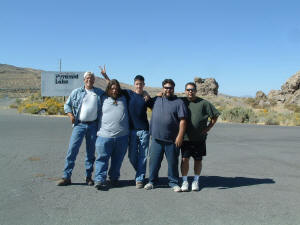
We hit took I-80 East to 427, then to 447. As we were on the road we
realized we had no firewood. We all felt this was critical to our success.
At Nixon we got directions to the Pyramid Lake Store that might have firewood, so
off we went. The advice proved to be correct the store did have wood, and
the drive along the lake was just breathtaking.
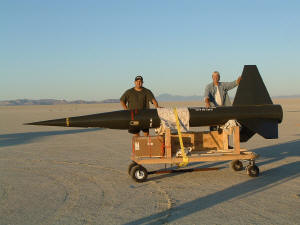 Unpacking
Unpacking
Upon arrival on the lakebed all the Black Rock Dessert virgins were in awe at
the expanse of the lakebed. We took everything out of the truck and
started to setup camp. The rocket looked great sitting on the lakebed, we
couldn't wait to see it fly.
Prep Day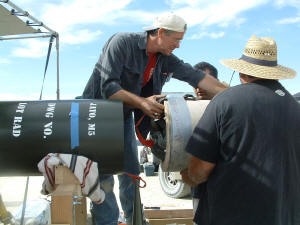
Friday was designated the prep day for the rocket. Neil McGilvray and
Bob Utley would be responsible for prepping the motor while Jeff and I would
take care of the airframe. Funny thing happens when you bring out an 8"
diameter motor six feet long; people just naturally want to look and help.
In a short amount of time Neil and Bob were being assisted by Paul Robinson of
AMW and Pat Gordzlik VP of the
Tripoli Rocket Association. Not bad company to keep. All day Friday
there were numerous conversations on how much Thermite to use in igniting this
motor. Estimates ranged from 85 grams down to 30 grams. Some of the
best minds in rocketry today weighed in on how much to use and why. This
was a critical number and we wanted to be sure to get it right. By the end
of the day, the motor was built and the rocket was ready to take to the pad.
David Reese mixed up the Thermite, while Rick Dickinson made the igniter.
Using three Daveyfire 28F and a paper tube, Rick carefully poured the Thermite
mixture into the tube. Turns out the tube Rick had made would only hold 55
grams of Thermite thus settling the hotly debated topic of how much to use.
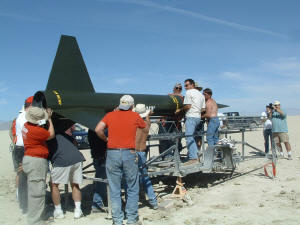 At
the Pad
At
the Pad
The trip to the pad was pretty uneventful. Jeff had built a fine
looking cart to transport the rocket to the
pad, and all went well getting there. The pad we used was built by Dave
Barbour of Team Numb out of Oregon. This was a fine launcher, trailer
mounted and was very sturdy and stable. Getting the rocket onto the launcher
was a pretty easy task with the exception that Team Numb had just launched a Q
motor from it and dug a 8" deep by 8 foot diameter hole under it. This
caused a few stumbles but no one lost it in the hole.
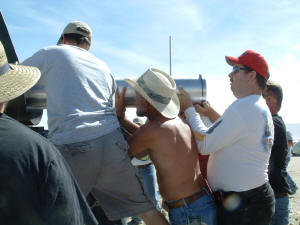
Once the rocket was loaded onto the launcher it came time to move the 170
pound motor into the rocket. This took quite a few hands but once it was
in, things really looked great.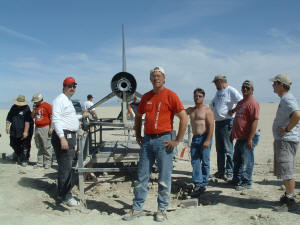
Pin the nose and arm the electronics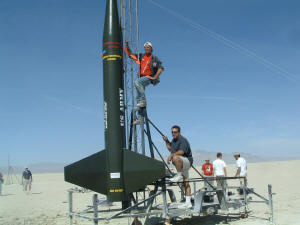
Things had been going really well up to this point. This should have
been a warning but we were just feeling very well planned out. The next
step was to drill three hole for the shear pins. We had already selected
the drill bit and chucked it into the drill. Michael Wilkins drilled the
first hole, and tried to insert the shear pins. Oooops, drill too small.
Larger drill bit, and now the pins were too small. Ok, a little tape on the
pins and things were fine.....So we thought. When it came time to arm the
electronics we realized we'd made a pretty big mistake. At the camp we put
on the nose, and had turned it so the decals looked the best. When it came
time to arm the electronics we found there was something more important to
consider than the decals; it was the position of the hatches themselves.
Turns out we placed the nose cone on, in the worst possible manner. The
hatch with the ARTS altimeter the easiest one to arm was placed facing the tower itself.
The backup electronics was facing directly away from the tower, this would mean
that someone would have to hang like an ape off the tower, insert the
screwdriver and twist the screw. To make matters worse it would be almost
impossible to see the LED on the ALTACC. While on the pad I attempted
to arm the ALTACC. I put the screwdriver into the hole, but couldn't feel
the screw head.
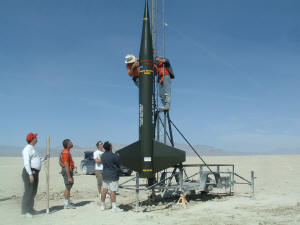
Pat Gordzlik climbed the tower to lend a hand, I explained I couldn't get the
ALTACC to arm. He tried to no avail. Then I suggested putting the
screw driver into the other hole. Oh, there's the screw. Pat twisted
but couldn't see any flashing from the LED. Time to make a command
decision. I told Pat that if the ARTS powers up and beeps correctly we fly
with the primary only. If not, we're done for the day, because the wind was
coming up. A flick of the switch and the ARTS beeped continuity on both
channels. We were go for launch.
Fall Back and Launch
The launch controller for the tower was positioned about 1500' from the tower,
this made for a long walk. The wind was increasing all the time, and I was
getting really worried. We arrived at the key switch, called the LCO and
we were cleared to go. The LCO did the count as I stood by the button, at
T-minus 0 I hit the button and 55 grams of Thermite did their job in
microseconds. The rocket literally leaped off the pad on a 20 foot flame.
As the rocket passed in front of the sun the Mach Diamonds were clearly visible
in the exhaust. The ride to apogee was fairly straight with the rocket
weather cocking into the wind slightly. The rocket went out of sight and
the wait for chutes seemed to take an eternity. Soon we heard the yelling,
"I see a chute" and we knew we'd done it.

Photo by Steve Jurvetson,
www.flickr.com/photos/jurvetson
The Recovery
The recovery was not thought out very well in deed. While we were
staring at the rocket we realized..."Hey we have to get that thing" I'll let
Rick Dickinson take over from here:
Jeff & Wedge's rocket flew beautifully, and was descending very slowly
under the 48' chute. About half a dozen of us jumped into a car, and
tore off across the desert to go catch up with it, to deflate the chute when it
landed.
We caught up with it when it landed, jumped out, and started grabbing hold of
the rocket airframe and shock cord. Someone sat on the rocket
itself, to force it to dig in as an anchor, while another guy drove the car
around to park on the shock cord.
Meanwhile, the rest of us are grabbing the shock cord (think 250' long red seat
belt), hanging on for dear life, and trying to work our way
closer to the chute in the lulls between wind gusts when the chute hits the
ground and partially deflates before bouncing back up again.
At one point, I was the closest to the chute, and it hit the ground particularly
hard, and deflated about halfway. I thought it was finally
going to stay down, if we could just keep the cord pinned down. So, I ran
forward a few yards and dove onto the shock cord, kneeling on it
with my full weight in order to let someone else run further up the cord.
Unfortunately, a moment or two later we were hit with a huge gust of wind, which
fully inflated the chute and flipped me up in the air like a
rag doll. I'm not positive, but I think I flipped completely over, and I landed
hard on my shoulder. My wife had sprained her ankle a few
weeks ago, and the pain I felt in my upper arm seemed to match what she
described in her ankle, so I assumed I had probably sprained my
shoulder.
Someone gave me a ride back to the campsite, and I sat for a while putting ice
on it, and took some ibuprofen to keep the swelling down.
It was very uncomfortable, and the only position that was tolerable was with my
arm bent at the elbow, and sticking out in front of me. If I
tried to put it in "sling position" against my chest, it hurt even worse.
After a little while, Melinda convinced me I should at least take the shirt off
and have someone look at it. They found a couple of doctors
at the launch (although the obstetrician wasn't much help, as I wasn't fully
dilated yet). As soon as my shirt was off, they could see my
shoulder was clearly dislocated. Everyone agreed I needed to seek medical
attention ASAP, so Melinda volunteered to take me in to Reno to the hospital.
Melinda and Wedge's son, Jimmy, took me to the hospital. One long drive
followed by a VERY long wait later, the doctors finally doped me up, yanked
things back into position, and then took a few x-rays to make sure it was all
back where it belonged, and that there were no broken bones. Would have
made more sense to me to confirm nothing was broken *before* they yanked it back
into place, but I guess that's why I'm not a doctor. In any case, the
x-rays came out fine, and they released me.
We stopped at Walgreen's to fill my pain pill prescription, and they said it
would be over an hour's wait. So, since we were in Reno, and since I was
feeling much better as a result of no longer having one arm an inch or two
longer than usual, we walked a block or two down to Circus
Circus, and gambled for an hour. Melinda and I both won a little cash at the
blackjack tables -- I used my winnings to fill up their tank on
the return trip to the desert.
If ever there was a person who went above and beyond the call, it's Melinda. I
hope you realize what a great gal you've got, Wedge. This
one's definitely a "keeper". My personal thanks go out to everyone who
helped me out. I don't remember everyone's names, as I was somewhat distracted
at the time. But, I sincerely appreciate everything that everyone did for
me, and the concern and well-wishes, as well.
Rick Dickinson
Flight Data:
![]()